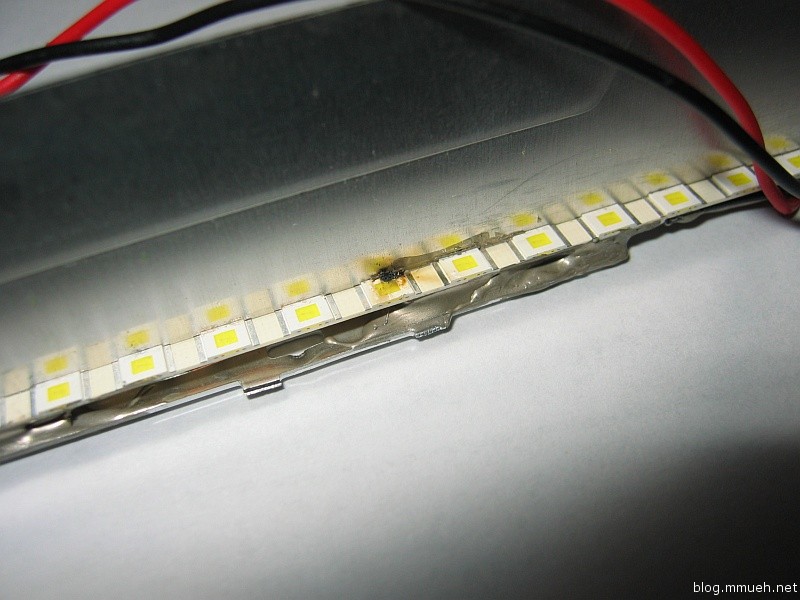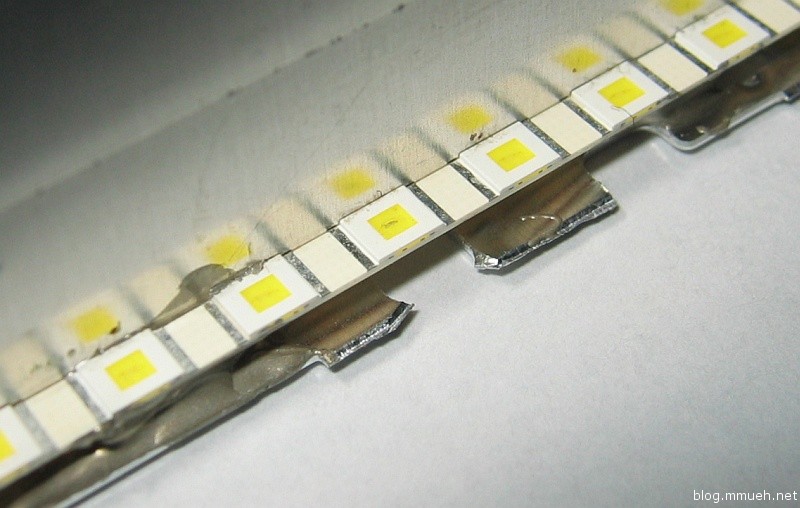The first version of the LED switching driver just exhaled a portion of magic smoke. The IC is neither the culprit nor the victim, there must have been a short somewhere else. The sense resistor was fried and acted as a fuse, but it wasn’t fast enough to prevent the current blowing another transistor on the motherboard that switches power to the backlight. Funny, didn’t even know there was such a thing. Maybe that explains the weird current shortages at the LED driver input that caused some of the flickering. The LT chip seems to have survived just fine, again.
Whoops, forgot to mention: Yes, it has been running ever since the last post about the topic ;-) so far, so good.
Anyways, gotta do this one again. To counter the problems with flickering, the new driver will run from 5V of the HDD/USB supply, operating in pure boost mode. Stepping from 5V to 9.6V will never cause it to even get near the crossover point where it would need to switch from boost to buck mode, and there will never be a lack of control range.
To explain that part, remember that the LT3518 runs in fixed frequency mode and varies only the pulse/pause ratio of the switch that draws power through the inductor. Let’s also assume we are in buck (stepdown) mode and the output current (LED current) is the variable the IC is trying to regulate. As the output voltage of a step-down converter is proportional to the on-time of the switch, the switch needs to be open all the time when the input voltage drops to or below the needed output voltage (that is, the voltage required to drive the desired LED current). Now, the LT3518 has a limitation in its pulse-duration caused by the design of its internal circuits, which in this case results in a maximum on-time of about 92%. If the required on-time rises above that, the IC can no longer guarantee proper function and instead of opening the switch permanently the regulating circuit begins to glitch, which results in flickering, low LED current and whatever else. It is not a danger for the LEDs though, because whatever happens, a step-up converter can never reach a voltage higher than its input.
I admit that I was kind of slacking off to assume it would work alright somehow – well, it didn’t ;-) Lesson learned, that’s why I don’t mind this happening. Sometimes doing it wrong is the only guarantee you’ll do it right the next time. The next version of the driver circuit will come with full eagle layouts and stuff; so please don’t get too hooked to the old design. It is only usable if you can guarantee a, let’s say, 2V surplus over the typical output voltage at the input all the time.
The new design will probably be done and up here ’til Sunday this week, and there will be some extra stuff with the CNC (stepper driver ICs arrived, some work on the axis’)





